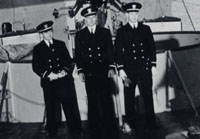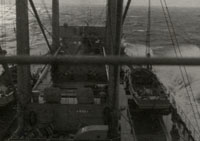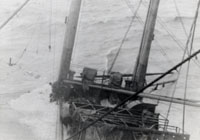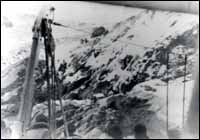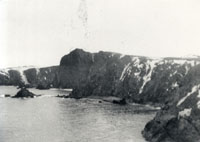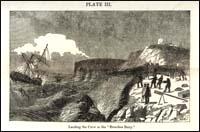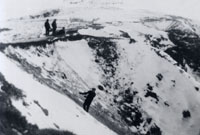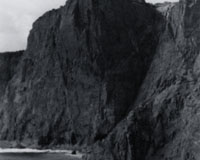Chapter 2: The Story – Dead Reckoning
Aground
The three ships pressed through the storm during the early hours of February 18. Each destroyer was supposed to be about a mile or two from the Pollux, but none of the ships could see each other through the snow, sleet, and fog. Communication between the vessels was spotty at best. The convoy was operating under strict orders of radio silence so that U-boats monitoring the airwaves could not detect their locations. The vessels could communicate with each other using light signals, but visibility was low in the storm and blinking lights could not always penetrate the thick veil of blowing snow. Neither the Pollux nor the Truxtun knew where any of the other ships in the convoy were and assumed they were following their plotted courses. The Wilkes was picking up the other two ships on radar, but its readings were unreliable in the icy conditions.
Suddenly, at about 4:05 in the morning, the Wilkes picked up a series of blips on its radar – land! And only about one and a half miles to the north if the equipment was working properly. Unease spread among the bridge crew – they were much closer to Newfoundland's rocky coastline than anyone imagined. Concern intensified into horror three minutes later when depth readings indicated the ship was steaming into dangerously shallow waters – in seconds, the water's depth dropped from 35 fathoms to a mere 15. “Stand by for collision!” yelled Commander John Kelsey, captain of the Wilkes. “All engines full emergency stern!” But nothing could be done – at 4:09 on the morning of February 18, 1942, the Wilkes ran aground on the jagged rocks at the southwest corner of Lawn Head.
The ship's radioman was immediately ordered to break radio silence and broadcast a warning to the Pollux and Truxtun over a distress frequency. A thick layer of slushy ice, however, was covering part of the ship's radio equipment and preventing any signals from getting through. By the time the ice was cleared away 15 minutes later and the message was sent, it was too late. The Truxtun ran aground at Chambers Cove at 4:10 in the morning and the Pollux at Lawn Point seven minutes later.
Below deck it was chaos. On all three ships, most men were asleep in their bunks and under darkened conditions when they went aground. They were awakened by the loud screech of metal on rock and a tremendous jolt. The force of the impact toppled over some bunks, tossed men from others, and sent stools, books, and other objects flying from one end of the sleeping quarters to the other. Panicked and disoriented sailors scrambled for their foul-weather gear and headed topside. Most thought they had been torpedoed or collided with another ship in the convoy. When they reached the deck, they were stunned to see snow-covered cliffs looming in the near distance. No one had anticipated grounding. Alfred Dupuy of the Pollux later described what he saw: “They had the search lights on, playing on the cliffs – and my God! – bleak nothing. Rocks, waves, white caps. Waves high as a building slamming up against the reefs and it was – it scared you really.” (Tape 71, 2:48-3:09)
The Pollux and Truxtun were badly damaged. Both ships' hulls had been pierced by rocks and they were releasing fuel into the water. The two vessels tried to free themselves, but with no luck – the Pollux was firmly impaled on one rock at Lawn Point and the Truxtun was wedged between two more in Chambers Cove. Giant waves picked up the vessels and dropped them on the jagged ocean floor. It was only a matter of time before the battering force of the ocean, combined with the weight of water pouring into the ships, would break them to pieces. But for now, neither captain thought there was any rush to abandon ship. The weather was stormy and it was still dark outside, so both crews decided to wait until daylight to take any further action. In the meantime, the men ate food to keep their strength up and went about various abandon ship procedures.
The Wilkes was in a much better situation. Only the front portion of the vessel had gone aground and Commander Kelsey felt that if weight was shifted to the rear, then the ship would be able to back off the rocks. He ordered crewmembers to move whatever portable cargo they could and turn on the engines every ten minutes. Finally, at 7:10 in the morning, the Wilkes freed itself. The vessel steamed to within about 1,000 yards of the Pollux to see if it could be of assistance, but in the bad weather and heavy seas, there was little the Wilkes could do but lay off and wait.
Daybreak – The Pollux
At daybreak, the crew of the Pollux assessed the situation. It was a bitterly cold and stormy morning. The waters were still rough – 12-feet-tall waves poured over the deck and threatened to wash sailors overboard. The Pollux was trapped about 65 feet from a rocky ledge that rose some 25 feet out of the water. Behind that was a tall icy cliff, approximately 100 feet high. The ledge appeared to be the only place the men could land. It was close, but in order to reach it they would have to cross violent and freezing waters.
Nonetheless, the battering force of the ocean would eventually break the Pollux to pieces, so the men believed they had to abandon ship. “It's difficult for me to describe to you the feeling of knowing that you're standing on a ship that's going to pieces, that land is almost so close you can touch it, but you can't get to it,” Ensign Alfred Pollack later said of that morning. “Obviously many things run through your mind, you know, whether you're going to see the sun come up that day or not, or whether this is the end and what kind of an end it's going to be.” (Tape 36, 2:13-2:33)
The crew first tried lowering lifeboats into the water, but to no avail – powerful waves thrashed the small vessels against the Pollux and splintered them to bits. Then the men tried to get a liferaft into the water. These, however, were stored onboard the ship, which created difficulties. The angle at which the Pollux was wedged between the rocks meant the crew had to push the raft uphill over a tilting and ice-covered deck. In the end, and with about 20 sailors pushing and heaving the raft uphill, they managed to drop it in the water.
Three men – George Bradley, Rex Copeland, and Bill McGinnis – volunteered to row it to shore. A long rope connected the Pollux to the raft; if the men made it to the ledge they could use this to fasten a line from ship to shore. From this, a rescue device known as a breeches buoy could be rigged and used to transfer the rest of the crew to land.
The three volunteers climbed down cargo nets hanging over the side of the ship and jumped into the raft. Freezing waves immediately poured over them. Gasping for air, the men paddled with all their strength toward shore, but it was no use – stronger waves breaking off the rocks pushed them back toward the supply ship. Making matters worse, the rope became tangled in wrecked lifeboats and other debris surrounding the ship. No matter how hard they paddled, they could make no progress. Frustrated and desperate, Bradley jumped out of the raft and tried to swim to shore with the rope in tow. By now, fuel leaking out of the Pollux had formed a semi-congealed sludge not far from the ship. Bradley did not have the strength to swim through that and the icy water. Numb and dejected, he returned to the raft and the three men were pulled back aboard the Pollux.
A second attempt was made to get the raft to shore, this time by Alfred Pollack and James Boundy. The two men felt that if the first three volunteers had entered the raft in less cumbersome clothing, then they may have made it to shore. After stripping down to swimming trunks and covering their bodies in grease for insulation, they boarded the raft and tried paddling to shore. Again, the waves tossed the raft back to its mother ship no matter how hard the men paddled, and again numb volunteers climbed back aboard the Pollux.
Unable to paddle to land, the crew sought out other ways to attach a line to shore. Someone suggested throwing a grapnel hook to the ledge. After a few tosses, the hook snagged securely into a crevice in the rock face. Finally – a line from ship to shore! It wasn't strong enough to support a breeches buoy, but it just might allow one of the lighter men on board to climb across and rig a proper line. Henry Strauss volunteered. Hand over hand and trailing a lifeline, he worked his way along the rope. Strauss later said that to keep himself motivated, he imagined his wife Jo was waiting for him on the rocks below. Just as he was about to reach the ledge, however, a giant wave knocked him off the rope and into the frigid ocean. Frantically, his shipmates pulled on the lifeline and hauled him back on board, making Strauss the fifth numb volunteer to board the Pollux that morning.
Undeterred by setbacks, the crewmembers tried a new plan. They decided to attach a rope ladder to one end of a 50-foot cargo boom (essentially a long pole) and extend that from ship to shore. In theory, a volunteer could cling to the rope ladder and climb down to shore once it was in position. Undiscouraged by his recent near-death experience, Strauss once again volunteered to try and reach shore. Despite his bravery, however, and despite his shipmates' efforts, the boom proved to be about 10 feet too short to reach shore. Twice Strauss had come within several feet of land, and twice he had to return to the Pollux. By now it was about 9:00 in the morning and the crew had made little progress. They knew the Wilkes was watching offshore, but they did not know where the Truxtun was.
